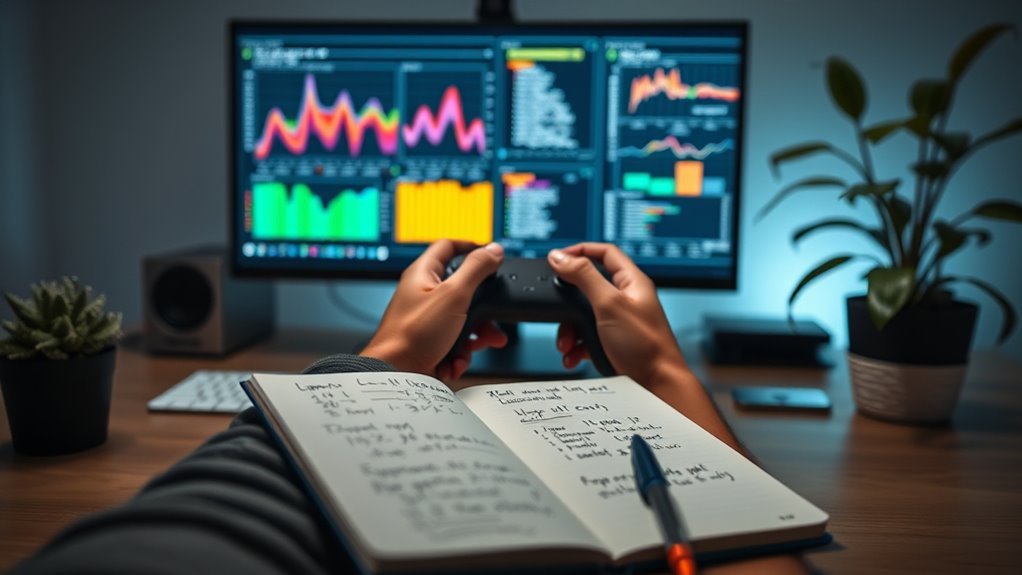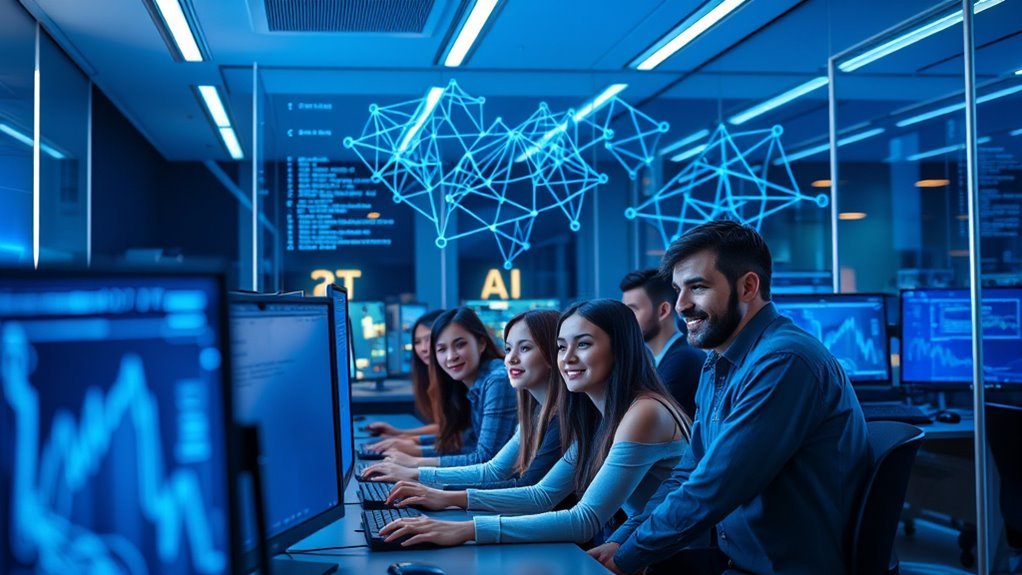If you want to explore reinforcement learning with OpenAI Gym, start by setting up your environment to guarantee hardware compatibility and install dependencies like Python and TensorFlow or PyTorch. Choose suitable Gym environments—from classic control tasks to complex robotics simulations—that match your experiment goals. Build agents using algorithms like Q-Learning or policy gradients, carefully tuning hyperparameters and monitoring key metrics like cumulative reward. Following a structured approach lets you optimize performance and troubleshoot common issues efficiently, paving the way for more advanced experimentation.
Understanding the Basics of Reinforcement Learning

Although reinforcement learning can seem complex at first, it’s fundamentally about training an agent to make decisions by interacting with an environment. You’ll focus on understanding environment dynamics and how value functions estimate expected rewards, guiding policy iteration to enhance decision-making. Efficient exploration strategies are essential for balancing the trade-off between exploring new actions and exploiting known rewards, while reward shaping accelerates learning by refining feedback signals. Model free methods let you learn effective policies without explicit environment models, enhancing sample efficiency. If you’re working with multi agent systems, collaboration and competition introduce additional layers of complexity, requiring careful design of interaction protocols. Mastering these fundamentals grants you the freedom to develop adaptable, robust agents capable of solving diverse, dynamic problems.
Setting Up Your Environment for OpenAI Gym

Before you can start experimenting with reinforcement learning algorithms, you’ll need to properly set up your environment to work with OpenAI Gym. Begin by evaluating system compatibility to verify your hardware and OS support necessary dependencies. Next, perform environment configuration by installing Python and required library dependencies via pip, carefully managing version control to avoid conflicts. Allocate resources efficiently, especially if using GPU acceleration, to enable performance optimization. Integrate OpenAI Gym seamlessly with other frameworks, such as TensorFlow or PyTorch, to expand your development flexibility. Should installation troubleshooting arise, check for missing packages or incompatible versions promptly. By methodically addressing these aspects, you’ll establish a robust setup that grants the freedom to focus on developing and testing reinforcement learning models without technical hindrances.
Exploring Popular OpenAI Gym Environments

You’ll encounter three main types of environments in OpenAI Gym: Classic Control Tasks, Atari Game Challenges, and Robotics Simulation Environments. Each category presents unique state and action spaces, requiring tailored algorithms and evaluation metrics. Understanding their distinct characteristics will help you select the appropriate environment for your reinforcement learning experiments.
Classic Control Tasks
Five fundamental classic control tasks in OpenAI Gym provide a structured environment for testing reinforcement learning algorithms. You’ll engage with classic control challenges like CartPole, MountainCar, and Acrobot, where classic control agents learn to balance or reach goals via classic control algorithms. These tasks are essential for understanding classic control applications and refining agent strategies under constrained dynamics.
| Task | Objective | Key Challenge |
|---|---|---|
| CartPole | Balance a pole on a cart | Stability under force |
| MountainCar | Drive car up a hill | Momentum buildup |
| Acrobot | Swing a double pendulum | Coordinated control |
Mastering these tasks equips you to innovate freely while grounding solutions in proven methodologies.
Atari Game Challenges
Although classic control tasks offer foundational challenges, Atari games introduce a richer set of environments with high-dimensional visual inputs and complex dynamics. When you engage with Atari game mechanics, you face varying game difficulty scaling that demands adaptive agent strategies. Each environment’s reward structures are often sparse or delayed, complicating the training challenges you encounter. Environment variability requires your agent to generalize across diverse scenarios, pushing performance benchmarks higher. Through rigorous gameplay analysis, you can identify patterns that inform policy optimization and exploration techniques. This complexity in Atari environments provides a robust testbed for reinforcement learning algorithms, enabling you to explore nuanced interactions and refine your models. By mastering these challenges, you gain greater freedom to innovate within reinforcement learning frameworks.
Robotics Simulation Environments
Building on the complexity found in Atari environments, robotics simulation environments in OpenAI Gym offer a distinct set of challenges rooted in continuous control and physics-based interactions. You’ll engage with precise robotics control requiring high simulation accuracy to replicate real-world dynamics. Tasks emphasize robot navigation through environments with varying complexity, demanding adaptive strategies. Physical interactions are critical, as manipulating objects or maintaining balance depends on accurate sensor integration. You’ll appreciate the necessity for task adaptability, as environments often require shifting behaviors based on new goals or obstacles. Additionally, multi agent systems introduce coordination challenges, requiring simultaneous control over multiple robots. This blend of factors pushes the boundaries of reinforcement learning algorithms, providing you with a robust platform to develop and test advanced control policies in realistic, physics-driven robotic scenarios.
Building Your First Reinforcement Learning Agent
You’ll start by configuring the OpenAI Gym environment to match the requirements of your agent, including setting observation and action spaces. Next, you’ll implement the core components of your agent, focusing on state representation and action selection mechanisms. Finally, you’ll initiate the training loop, where the agent interacts with the environment to optimize its policy through iterative learning.
Environment Setup Steps
Before you can train your reinforcement learning agent, you need to correctly configure the environment where it will interact and learn. Start by ensuring that all environment prerequisites are met, including installing Python 3.6 or higher and a compatible package manager like pip. Next, install software dependencies such as OpenAI Gym, NumPy, and any rendering libraries necessary for visualization. It’s essential to create an isolated virtual environment to maintain version control and avoid conflicts. Afterward, verify the installation by running simple Gym environment examples to confirm your setup functions correctly. This methodical approach guarantees a stable platform for your agent to explore and learn, giving you the freedom to experiment without technical hindrances. Proper setup is foundational for effective reinforcement learning development.
Agent Training Basics
Once your environment is properly configured, the next step involves defining the agent’s interaction framework, including state representation, action space, and reward signals. You’ll select agent types—value-based, policy-based, or hybrid—tailoring training techniques accordingly. Establish reward structures that precisely guide behavior, balancing immediate and long-term gains. Exploration strategies such as ε-greedy or entropy regularization help the agent discover ideal policies without premature convergence. Carefully tune learning rates to guarantee stable updates. Monitor convergence criteria to decide when training duration is sufficient, preventing overfitting or undertraining. Use performance benchmarks to evaluate progress quantitatively. Policy evaluation, through metrics like cumulative reward or loss reduction, informs iterative refinement. By methodically integrating these components, you’ll build a robust reinforcement learning agent in OpenAI Gym, granting you freedom to experiment and enhance efficiently.
Implementing Q-Learning With Openai Gym
Although implementing Q-Learning with OpenAI Gym requires understanding both the algorithm and the environment interface, you’ll find that the process is straightforward when broken down into clear steps. Start by initializing a Q-table representing state-action values, reflecting q learning fundamentals. Interact with the environment to collect state changes, updating the Q-table using the Bellman equation. Focus on algorithm optimization by tuning parameters like learning rate, discount factor, and exploration policy to balance exploitation and exploration efficiently. Use Gym’s step and reset functions to manage episodes systematically, ensuring your agent learns from diverse experiences. Monitoring convergence through reward trends enables precise refinement of your Q-learning implementation. This methodical approach grants you the freedom to customize and improve agent performance in various discrete action environments within OpenAI Gym.
Using Policy Gradient Methods in Gym Environments
While Q-Learning focuses on value-based methods by estimating action values, policy gradient methods offer a direct way to optimize the policy itself. When you work within OpenAI Gym environments, policy gradients enable you to parameterize your policy with differentiable functions, typically neural networks, and adjust parameters via gradient ascent on expected reward. This approach grants you greater flexibility in continuous or high-dimensional action spaces. Implementing an actor-critic algorithm combines the benefits of policy gradients with value-based learning: the actor updates the policy, while the critic estimates the value function to reduce variance in gradient estimates. By integrating actor-critic methods, you gain a stable yet efficient training process, empowering you to develop robust agents capable of adapting dynamically within Gym’s diverse environments.
Evaluating Agent Performance and Metrics
To effectively evaluate your agent’s performance, you need to identify key performance indicators that quantify success within the environment. Analyzing the reward signal provides insight into learning progress and policy effectiveness over time. Additionally, examining episode outcome metrics, such as completion rates and cumulative rewards, helps you assess overall agent behavior and stability.
Key Performance Indicators
Three critical metrics help you evaluate the performance of reinforcement learning agents in OpenAI Gym environments: cumulative reward, episode length, and success rate. These key performance indicators define the success criteria and guide your evaluation standards. To understand agent behavior and training efficiency, focus on:
- Learning curves that depict progress over episodes
- Performance visualization to compare algorithms effectively
- Training stability metrics ensuring consistent results
- Reward shaping impacts on cumulative rewards
Reward Signal Analysis
Although cumulative rewards provide a broad measure of agent success, analyzing the reward signal itself reveals deeper insights into agent behavior and learning dynamics. You’ll want to carefully examine reward sparsity, as sparse rewards can hinder learning, necessitating techniques like reward shaping to guide the agent effectively. Signal normalization helps maintain stable learning by preventing extreme reward values from skewing updates. When dealing with multi-objective rewards, balancing competing objectives through weighted sums or Pareto optimization is essential. Reward discounting adjusts the emphasis on immediate versus future rewards, influencing the agent’s temporal decision-making. Additionally, incorporating intrinsic motivation can encourage exploration beyond extrinsic rewards, fostering more robust policies. By methodically dissecting these aspects, you gain freedom to refine agent training with precision, enhancing performance beyond raw cumulative totals.
Episode Outcome Metrics
Evaluating agent performance hinges on carefully selected episode outcome metrics that capture the effectiveness of learned policies across complete interactions with the environment. To rigorously assess your agent, focus on metrics that provide clear insight into training episodes and policy robustness. These include:
- Episode statistics: Aggregate data like total rewards and episode lengths to summarize performance.
- Reward distribution: Analyze how rewards vary across episodes, highlighting consistency and outliers.
- Performance variance: Measure fluctuations in outcomes to understand stability and reliability.
- Success evaluation and failure analysis: Contrast successful episodes against failures for outcome comparison and targeted improvements.
Understanding the metric significance enables you to pinpoint strengths and weaknesses in your agent’s learning process, ensuring you maintain freedom to iterate and optimize policies effectively.
Troubleshooting Common Issues in OpenAI Gym
When you encounter issues in OpenAI Gym, understanding the root cause is essential for efficient troubleshooting. Start by identifying common errors such as environment compatibility problems or version conflicts between Gym and your reinforcement learning framework. Verify system requirements and guarantee proper installation to avoid setup-related issues. Use debugging techniques like log analysis to pinpoint failures in the reward function or unexpected agent performance. Confirm that the Gym environment integrates seamlessly with your codebase, paying attention to API changes across versions. If installation issues persist, reinstall dependencies in a clean environment. Methodically isolating each component—environment, agent, and framework—enables precise diagnosis. By maintaining a structured approach, you can swiftly resolve problems, preserving your freedom to experiment and innovate without technical hindrances.
Extending Openai Gym With Custom Environments
Since OpenAI Gym provides a standardized interface for reinforcement learning environments, extending it with custom environments allows you to tailor simulations to specific problems or research needs. When creating your own environment, focus on precise custom environment design by subclassing gym.Env and implementing essential methods like step(), reset(), and render(). After defining your environment, you’ll need to handle environment registration, which integrates it into Gym’s ecosystem for seamless access. Key steps include:
- Define observation and action spaces clearly to match your problem domain.
- Implement logical state changes and reward computations within step().
- Register your environment using gym.envs.registration.register() with a unique ID.
- Test your custom environment thoroughly to guarantee stability and correctness.
This approach grants you the freedom to innovate beyond standard benchmarks efficiently. Effective prompt engineering can further optimize AI interactions when integrating reinforcement learning environments with language models.
Best Practices for Reinforcement Learning Experiments
Although setting up reinforcement learning experiments can seem straightforward, adhering to best practices is essential for obtaining reliable and reproducible results. You should focus on environment selection and agent architecture to guarantee compatibility and scalability. Hyperparameter tuning and reward shaping directly impact training stability and agent performance. Consistent experiment logging facilitates iterative experimentation and model evaluation. Employ exploration strategies thoughtfully to balance exploration-exploitation. Finally, performance benchmarking provides objective metrics to compare approaches.
| Practice | Purpose | Key Considerations |
|---|---|---|
| Environment Selection | Guarantees relevant task complexity | Compatibility, stochasticity |
| Agent Architecture | Defines learning capacity | Model size, layers, activations |
| Hyperparameter Tuning | Optimizes training dynamics | Learning rate, batch size |
| Experiment Logging | Enables reproducibility | Metrics, parameters, seeds |
| Performance Benchmarking | Measures effectiveness | Baselines, statistical tests |



